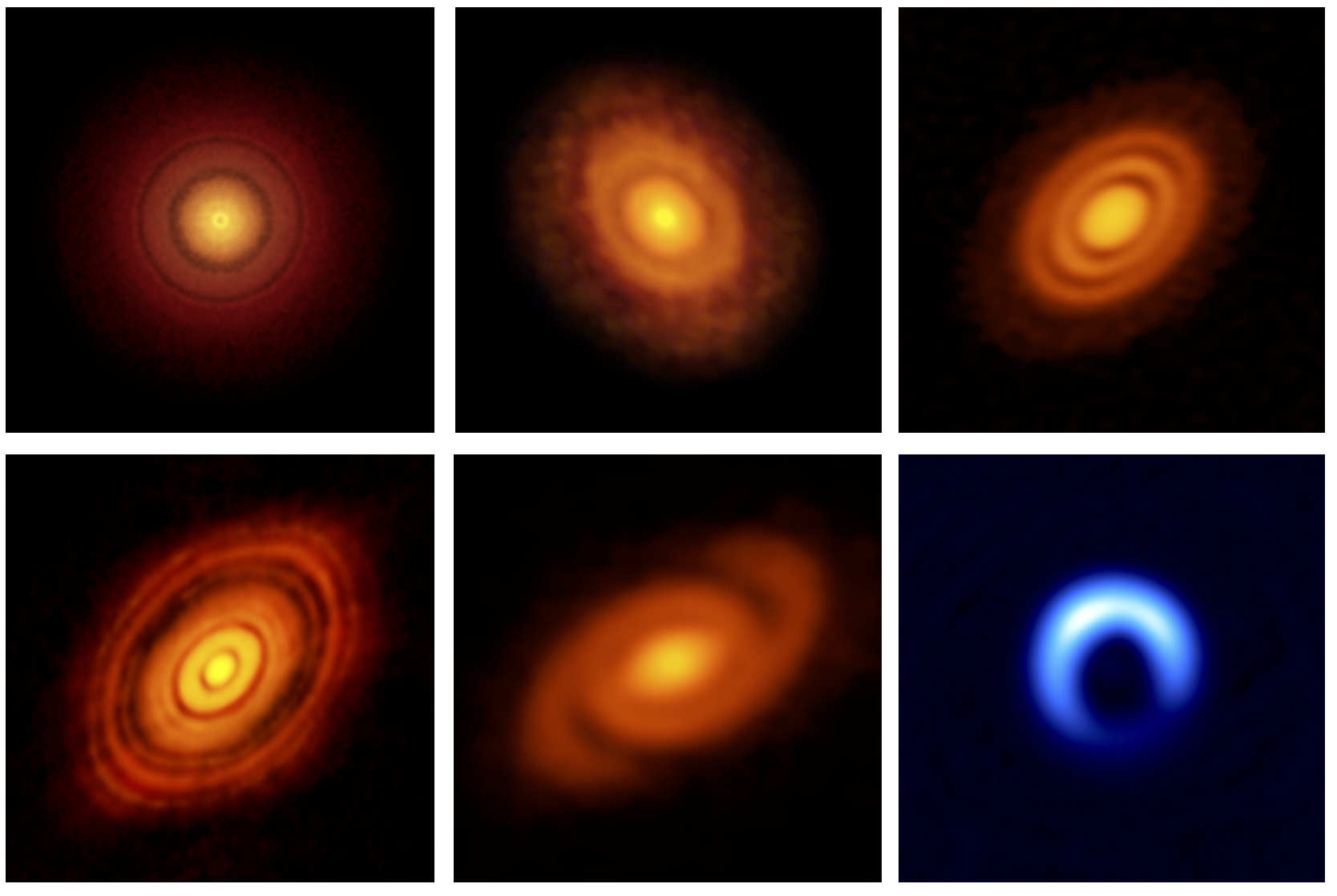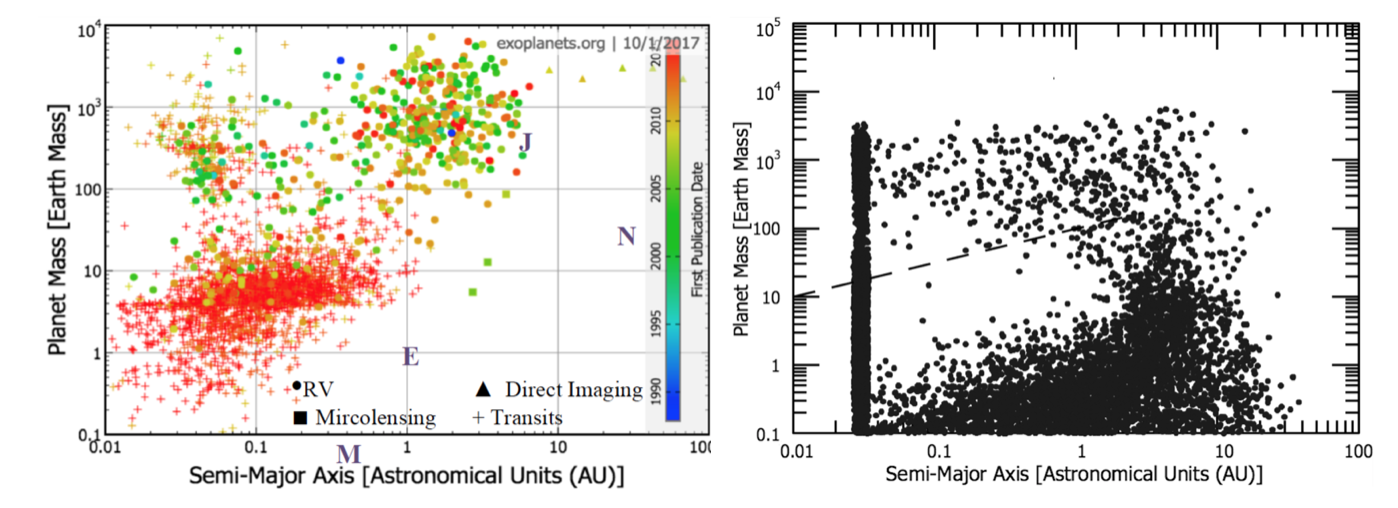Asymmetries in planet forming discs
In the last few years we have been able to observe the planet forming environments (protoplanetary discs) with unprecedented resolution and sensitivity. This revolution has primarily been driven by the ALMA telescope, and has produced spectacular images of protoplanetary discs.
 Caption: ALMA images of planet forming discs, image credit ESO/NAOJ/NRAO.
One of the mysteries is the origin of highly asymmetric discs (bottom right panel of the Figure). An explanation is that these discs contain anti-cyclonic vortices which are trapping large quantities of small solid particles (mm-sized dust particles). However, the question remains: how do you get large scale vorticies in protoplanetary discs? In Owen and Kollmeier 2017, we suggested that thermal feedback from a forming planet could provide the necessary source of vorticity to form large scale vorticies (see video below). This project will involve developing this model further, including more detailed planet formation calculations and computer simulations of vortex formation and destruction. A detailed description of the project can be found here.
Caption: ALMA images of planet forming discs, image credit ESO/NAOJ/NRAO.
One of the mysteries is the origin of highly asymmetric discs (bottom right panel of the Figure). An explanation is that these discs contain anti-cyclonic vortices which are trapping large quantities of small solid particles (mm-sized dust particles). However, the question remains: how do you get large scale vorticies in protoplanetary discs? In Owen and Kollmeier 2017, we suggested that thermal feedback from a forming planet could provide the necessary source of vorticity to form large scale vorticies (see video below). This project will involve developing this model further, including more detailed planet formation calculations and computer simulations of vortex formation and destruction. A detailed description of the project can be found here.
 Caption: ALMA images of planet forming discs, image credit ESO/NAOJ/NRAO.
One of the mysteries is the origin of highly asymmetric discs (bottom right panel of the Figure). An explanation is that these discs contain anti-cyclonic vortices which are trapping large quantities of small solid particles (mm-sized dust particles). However, the question remains: how do you get large scale vorticies in protoplanetary discs? In Owen and Kollmeier 2017, we suggested that thermal feedback from a forming planet could provide the necessary source of vorticity to form large scale vorticies (see video below). This project will involve developing this model further, including more detailed planet formation calculations and computer simulations of vortex formation and destruction. A detailed description of the project can be found here.
Caption: ALMA images of planet forming discs, image credit ESO/NAOJ/NRAO.
One of the mysteries is the origin of highly asymmetric discs (bottom right panel of the Figure). An explanation is that these discs contain anti-cyclonic vortices which are trapping large quantities of small solid particles (mm-sized dust particles). However, the question remains: how do you get large scale vorticies in protoplanetary discs? In Owen and Kollmeier 2017, we suggested that thermal feedback from a forming planet could provide the necessary source of vorticity to form large scale vorticies (see video below). This project will involve developing this model further, including more detailed planet formation calculations and computer simulations of vortex formation and destruction. A detailed description of the project can be found here.

 Caption: Observed exoplanets from exoplanets.org (Left). Previous theoretical prediction of the exoplanet distribution (Right, Ida and Lin 2008). Note that the gap in the theoretical prediction for close-in planets with masses in the range 1-100 Earth masses is completely filled by exoplanets. The difference between the observations and theoretical predictions is not well understood.
Protoplanetary discs live for about 10 million years before being dispersed rapidly and the observed exoplanets are billions of years old. Therefore planet formation occurs rapidly and then the planets evolve into the population we see today. The fact these planets are so close to their parent stars means there atmospheres are strongly irradiated. This extreme heating can cause the atmospheres of these exoplanets to hydrodynamically flow away. This planet ``evaporation'' causes these planets to lose mass over their lifetimes. This hydrodynamic outflow is shown in the video below.
A lot of this mass-loss occurs during the early phases of the planet's lifetime. While the planet is forming its atmosphere is pressure confined within the protoplanetary disc, yet when the gas disc disperses this pressure confinement disappears. This decompression causes the planet's atmosphere to expand and escape the planet's gravitational well. In
Caption: Observed exoplanets from exoplanets.org (Left). Previous theoretical prediction of the exoplanet distribution (Right, Ida and Lin 2008). Note that the gap in the theoretical prediction for close-in planets with masses in the range 1-100 Earth masses is completely filled by exoplanets. The difference between the observations and theoretical predictions is not well understood.
Protoplanetary discs live for about 10 million years before being dispersed rapidly and the observed exoplanets are billions of years old. Therefore planet formation occurs rapidly and then the planets evolve into the population we see today. The fact these planets are so close to their parent stars means there atmospheres are strongly irradiated. This extreme heating can cause the atmospheres of these exoplanets to hydrodynamically flow away. This planet ``evaporation'' causes these planets to lose mass over their lifetimes. This hydrodynamic outflow is shown in the video below.
A lot of this mass-loss occurs during the early phases of the planet's lifetime. While the planet is forming its atmosphere is pressure confined within the protoplanetary disc, yet when the gas disc disperses this pressure confinement disappears. This decompression causes the planet's atmosphere to expand and escape the planet's gravitational well. In